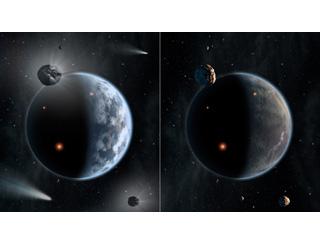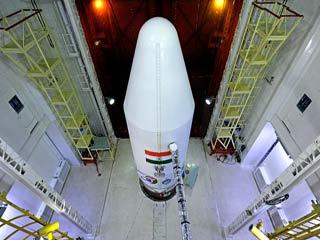
This artist's concept illustrates the fate of two different planets: the one on the left is similar to Earth, made up largely of silicate-based rocks with oceans coating its surface. Photo: NASA/JPL-Caltech.
WASHINGTON (PTI): Planets rich in carbon, including so-called diamond planets, may lack oceans, according to a NASA study.
Our Sun is a carbon-poor star, and as result, our planet Earth is made up largely of silicates, not carbon. Stars with much more carbon than the Sun, on the other hand, are predicted to make planets chock full of carbon, and perhaps even layers of diamond.
By modelling the ingredients in these carbon-based planetary systems, the scientists determined they lack icy water reservoirs thought to supply planets with oceans.
"The building blocks that went into making our oceans are the icy asteroids and comets," said Torrence Johnson of NASA's Jet Propulsion Laboratory in Pasadena, California, who presented the results at the American Astronomical Society Division of Planetary Sciences meeting in Denver.
"If we keep track of these building blocks, we find that planets around carbon-rich stars come up dry," he said.
Johnson and his colleagues said the extra carbon in developing star systems would snag the oxygen, preventing it from forming water.
"It's ironic that if carbon, the main element of life, becomes too abundant, it will steal away the oxygen that would have made water, the solvent essential to life as we know it," said Jonathan Lunine of Cornell University, Ithaca, a collaborator on the research.
Researchers identify exoplanets by first looking for those that are situated within the "habitable zone" around their parent stars, which is where temperatures are warm enough for water to pool on the surface.
But even if a planet is found in this so-called "Goldilocks" zone, where oceans could, in theory, abound, is there actually enough water available to wet the surface?
Johnson and his team addressed this question with planetary models based on measurements of our Sun's carbon-to-oxygen ratio.
Our Sun, like other stars, inherited a soup of elements from the Big Bang and from previous generations of stars, including hydrogen, nitrogen, silicon, carbon and oxygen.
These models accurately predict how much water was locked up in the form of ice early in the history of our solar system, billions of years ago, before making its way to Earth.
Comets and/or the parent bodies of asteroids are thought to have been the main water suppliers, though it is debated.
The objects are said to have begun their journey from far beyond Earth, past a boundary called the "snow line," before impacting Earth and depositing water deep in the planet.
When the researchers applied the planetary models to the carbon-rich stars, the water disappeared. "There's no snow beyond the snow line," said Johnson.
"All rocky planets aren't created equal. So-called diamond planets the size of Earth, if they exist, will look totally alien to us: lifeless, ocean-less desert worlds," said Lunine.
 Previous Article
Previous Article












The Indian Air Force, in its flight trials evaluation report submitted before the Defence Ministry l..
view articleAn insight into the Medium Multi-Role Combat Aircraft competition...
view articleSky enthusiasts can now spot the International Space Station (ISS) commanded by Indian-American astr..
view article